Funding Friday: Return To Sender
I love short films. I think they are a great way to tell a short story on a shoestring budget. I have seen some great ones over the years. So when I saw this Kickstarter project this morning, I backed it instantly.
I love short films. I think they are a great way to tell a short story on a shoestring budget. I have seen some great ones over the years. So when I saw this Kickstarter project this morning, I backed it instantly.
Aesop has some great fables but my favorite is The Tortoise and The Hare. I was reminded of it yesterday when I saw this chart in my colleague Nick‘s deck for a talk he is giving this week in Hong Kong:
That is the installed base of iOS phones vs Android phones globally over the last decade.
I have been a long and loud fan of Android’s open (or at least more open) model and an equally long and loud detractor of Apple’s closed model.
I’ve taken a lot of heat and ridicule for it over the years and still do.
But to me, there is no way to win long term with a closed model.
It is a lot like The Tortoise and The Hare.
Closed allows you to build a better user experience and get out of the gate quickly. Open takes longer, the user experience is poor initially and for quite a while, but when open gets going, it is unstoppable.
Continuing the year end theme, it is time for my annual recap of what happened this year, to be followed by a look forward tomorrow on the first day of the new year.
Last year I was not particularly confident in my look forward. I thought Trump would be President at the end of 2018, I thought the Republicans would lose control of the House, I thought the “techlash” would escalate, and I was worried about crypto. Those all turned out to be correct. But I had less clarity about the direction of the economy and the tech sector.
What actually happened was that 2018 was a year that we lost trust in tech, government, and a lot more.
Let’s start with tech. This chart I saw in Recode’s year end wrap-up says it well:
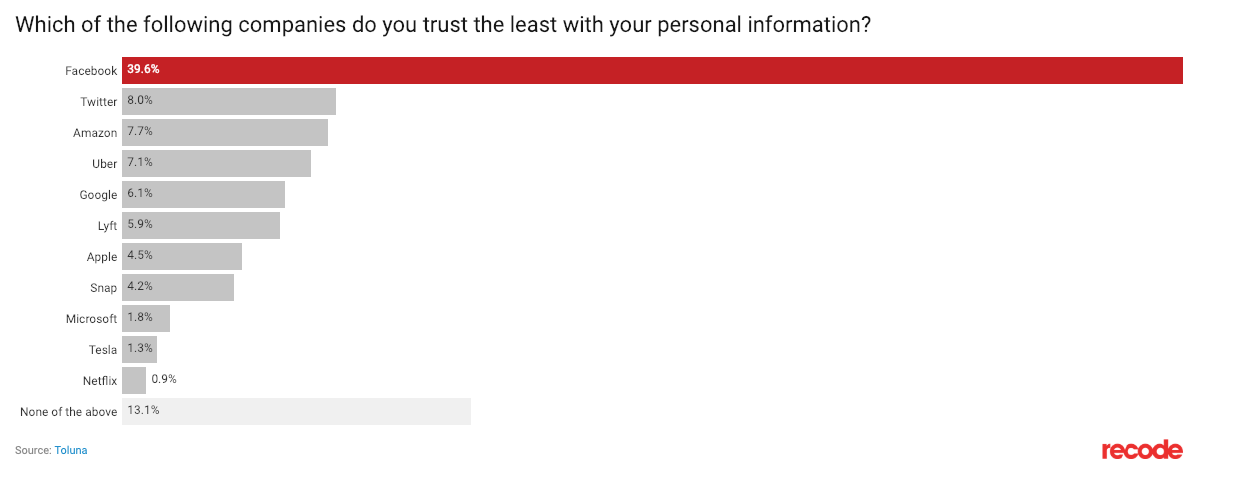
While much of the distrust is currently aimed at Facebook, the “I don’t trust you” numbers are growing for many other big tech companies.
I have always felt that search traffic on our portfolio company’s DuckDuckGo’s search engine is a great proxy for distrust of Google and that curve looks like it is going parabolic:
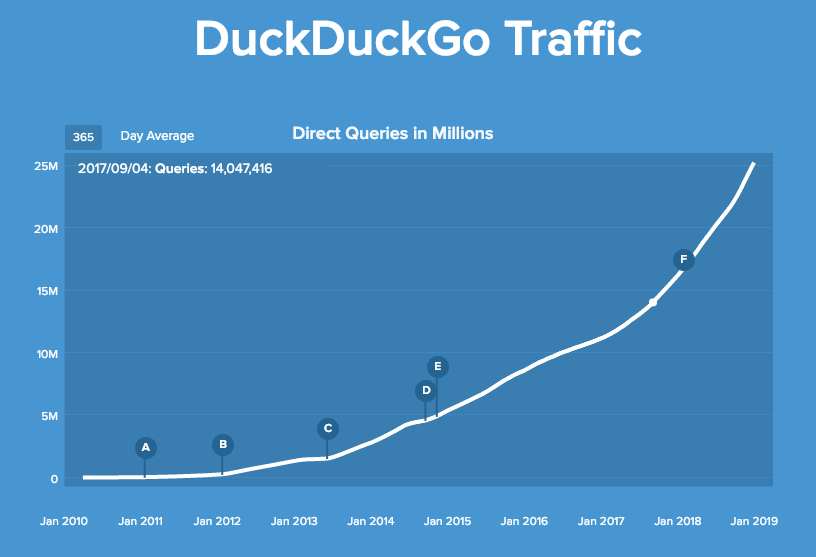
2018 also brought us GDPR, the first of what I expect will be multiple regulatory efforts to control the large tech companies’ use of our personal information for their gain and our loss.
But more important are our personal decisions about the technology we use and what we use less or stop using altogether.
In 2018, we saw social media usage in the US flatten out and possibly even start to decline a bit. Here is another chart from that Recode year-end wrap-up:
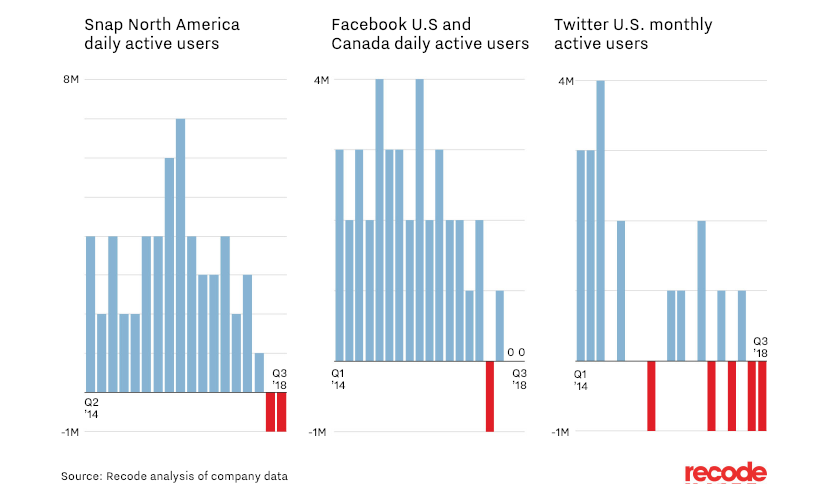
And the usage of screen time management apps, like Screentime on iOS, is surging. We know we are addicted to tech, we don’t want to be, and we are working on getting sober.
All of this lost trust is challenging for big tech, and the tech sector in general, but is also a huge opportunity for new companies and new technologies that can offer different products and business models that we can trust more, or don’t need to trust.
This loss of trust in 2018 was not limited to the tech sector. In the US, and also in many places around the world, we are losing trust in our institutions and our elected officials.
In the midst of the most charged political moment of 2018, the Kavanaugh hearings, I was talking to my mom who is 88 years old and has seen a lot and she said to me “I don’t know who to trust.” Neither do I. And I suspect most of us don’t either.
In the US, we have a President who is not trustworthy and may well be a criminal. We will get to that tomorrow when we look forward. And we have a Congress that no more than 20% of us trust and haven’t for over a decade.
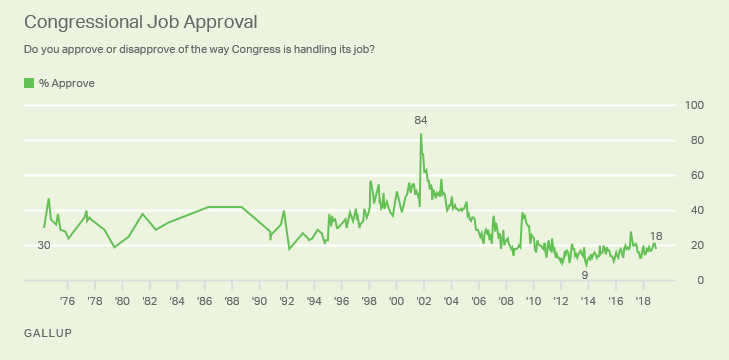
We also see the decline of democracy and the rise of autocracy around the world.
These are worrisome trends. But I am an optimist. See a problem, find a solution.
Which takes me to crypto, naturally.
On the surface, one would say that 2018 was a horrible year for crypto. This is the Bitcoin price chart from our portfolio company Coinbase:
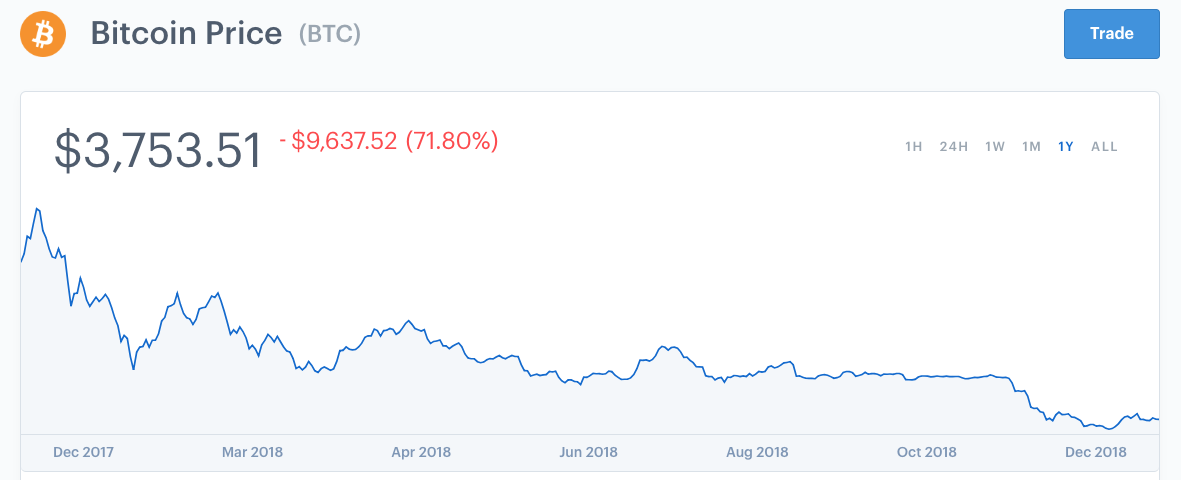
Native (token sale) fundraising for crypto is also way down:

But the truth is that 2018 was a year that the crypto market continued to prove its resiliency. Trading volumes declined massively but the underlying blockchains did not collapse.
This is a chart from Coinmetrics.io which shows the transaction volume of the top ten crypto-tokens by market cap over the years:

What this very busy chart tells me is that there are now many public blockchains that are supporting daily transaction volumes in the ten of thousands to hundreds of thousands.
I think this chart of Bitcoin transaction volume from Blockchain.com tells the story of 2018 well:

Crypto took a big hit in the first half of 2018 with the collapse of trading volumes. But the underlying strength of native blockchain transactions picked up the slack and it won’t be long until transaction volumes make new all time highs. Token Prices? Well that is another story, and more appropriate for the look forward tomorrow.
In summary, 2018 was a tough year for our institutions, including the big tech companies that are our new institutions. We are losing trust in them. And looking for new things to trust. Which also creates an opportunity for a post trust society. More on that tomorrow.
Happy New Year everyone.
I recently wrote about my new Pixel Slate. There is a lot I like about it and plenty more that I’m getting used to. I touched on most of that in my blog post.
I am writing this post on my Slate using the Slate Keyboard (you can see it in the left of the photo below.
One thing that I am totally smitten with is reading web content on it. The screen is big and crisp and it feels great in the hands. It’s like a huge phone, which is the device that I have been doing most of my reading on.
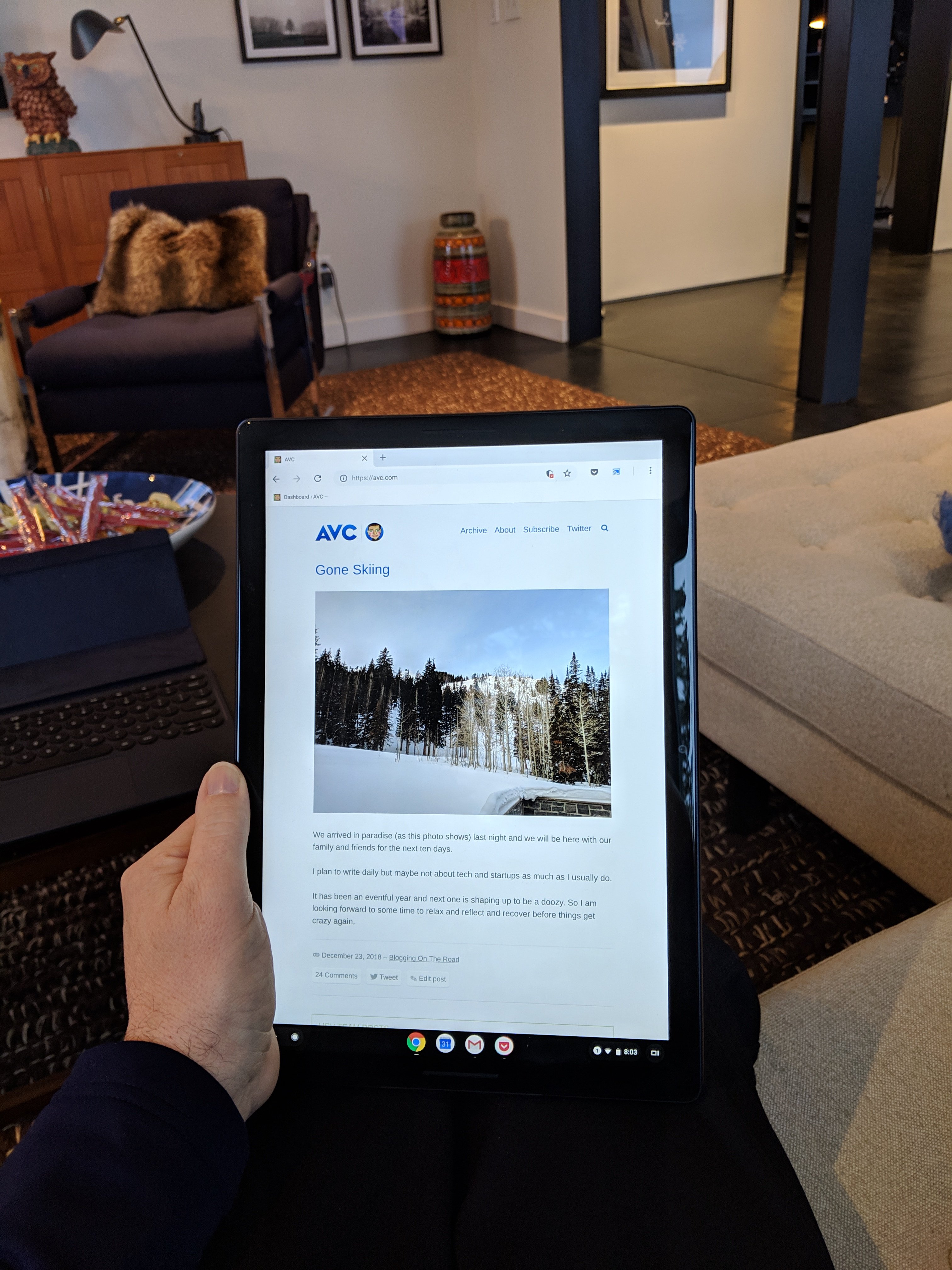
If you look at the bottom of the screen, you will see four icons; Chrome, Calendar, Gmail, and the fourth is Pocket.
I have just started using Pocket. It used to be called Read It Later and it was developed by Nate Weiner. Pocket was bought by Mozilla in 2017.
I selected Pocket because both of my daughters use it and several colleagues at USV do too.
While I have mostly been reading web content on my phone, I come across it in many places (email, twitter, google discover, reddit, hacker news, techmeme, etc) on all of my various devices . Believe it or not, I have typically stopped what I was doing and read it when I saw the link, or I would email the link to myself and read it later in my mail client on my phone.
But now that I have this Slate where I want to try and read all of my web content on, I am drawn to a service that exists on all of my devices (phone, desktop, laptop) and can collect all of the links and let me read them in one place.
So I am going to finally try and make the switch to a “read it later” service, something many of you have been doing for years now.
I do have some questions for those of you who use Pocket already:
1/ How do you save to Pocket links you come across in Twitter?
2/ How do you save to Pocket links you come across in Google Discover?
3/ Is there a way to save to Pocket directly in Gmail vs clicking on the link and launching in the browser and saving there?
So that’s one of the things I am up to on this year end holiday break. I appreciate all of your help in quickly making me a power Pocket user.
I went onto Kickstarter today to find, fund, and then feature a project on my regular Funding Friday post. I found so many great projects that I backed all of them and I have listed them below. Check them out, they are all great. And back a few of them too if you are so inclined.
When Governor Cuomo and the state legislature passed last year’s budget, they formed a committee to address the growing crisis in the NYC metro area transportation systems. That committee was chaired by my longtime friend Kathy Wylde, who runs and has run the NYC Partnership for many years. Anyone who knows Kathy knows she is all business and does not mince words. The world could use more people like Kathy, particularly in public service.
The committee released their report this week and you can read it here. The NY Times also covered the release of the report here.
The bottom line is that the MTA which controls much of the transit and tunnel and bridge infrastructure for the NYC metro area transit system needs between $45bn and $60bn over the 2020-2024 five year capital planning window. That compares to $33bn over the prior five year period from 2015-2019.
How does the city and state and region come with up to $60bn? Well, one of the ideas is to implement congestion pricing in the “central business district” in Manhattan. That is an idea that has been proposed a number of times over the years, most notably by Mayor Bloomberg during his tenure. It is a good idea and long overdue. A dense urban environment should have excellent mass transit and incentives to use it and should have disincentives to drive cars. Taxing cars in Manhattan and using the revenues to maintain and improve our subways seems like an obvious thing to do.
Congestion pricing in the central business district in Manhattan should produce upwards of $1bn a year in new revenues. If a surcharge was applied to “for hire vehicles” (taxis, Uber, Lyft, etc) in the same central business district, another $400mm a year could be generated.
If you bonded the $1bn, that could produce $15bn. If you bonded the for hire vehicle surcharge, that could produce another $9bn. Those are big numbers and would go a long way to funding the 2020-2024 capital plans.
But as Bliss McCrum, who taught me much about venture capital and recently passed away, would say “don’t put good money after bad without first making some changes.”
And the changes Bliss was talking about was the team, the operating model, and the strategy.
So the other recommendations from the committee should be taken seriously before fully funding the 2020-2024 plan. Breaking up the MTA is at the top of the list. It is a monstrous bureaucracy which is wasteful and badly mismanaged. If it were a privately held company, it would have been bankrupt and reorganized long ago. We should treat it as bankrupt and reorganize it now.
There is very little that can’t be fixed by good management, a business minded operating model, and a responsible investment plan. Unfortunately government is not rich with any of those. But our transportation systems should be and those in government can and should make that a priority. Nothing less than the future of our city is at stake.
With the news of Google and Amazon’s huge expansions into NYC, many people are asking “how did NYC tech get to this place?” Well, I am going to post a
But first, I’d like to talk about how I ended up doing that history lesson, which in and of itself is a history lesson.
When the Internet sector started to emerge from its nuclear winter in the late 2003/early 2004 (which is also when Brad Burnham and I went out and raised the first USV fund), those of us who were still working in the
Tim O’Reilly and John Battelle came up with it. They called the re-emergence of the Internet/web sector “Web 2.0” and they launched a conference called Web 2.0
By 2008, it was clear that NYC was increasingly an important part of the Web 2.0 story, by virtue of companies like Etsy, Tumblr, Delicious, and other important “web 2” companies started in NYC (and funded by USV).
So John and Tim decided to host a Web 2.0 Summit in NYC in 2008 and to celebrate that, they asked me to give a history lesson in the emergence of tech in NYC in the mid 90s. I did that and it remains one of my favorite talks I have given.
Here it is. I hope you enjoy watching it as much as I enjoyed doing it.
Our portfolio company SoundCloud just launched a pretty cool thing. If you are a DJ and use one of the popular DJ software products, you can plug SoundCloud into it and make your mixes right from the cloud.
Here’s a 15 second video advertisement for this new feature:
SoundCloud has announced that this feature is coming to all of the popular DJ software products soon.
It is great to see SoundCloud, a company that got its start with DJs, bringing all that it has built over the years back to it early users.
I don’t really use Waze that much. My trips are typically a combo of walking, biking, subways, and driving and Google Maps does a great job of offering all of those options. Waze is made for driving. So I am more of a Google Maps user than a Waze user.
But Waze has one feature that I am increasingly addicted to: the “plan a trip” later feature.
I am going to Brooklyn this morning for a Board Meeting and then I need to be in my office later. So I pulled out my phone, launched Waze, and figured out when I need to leave by (if I am going by car).
It looks like this:
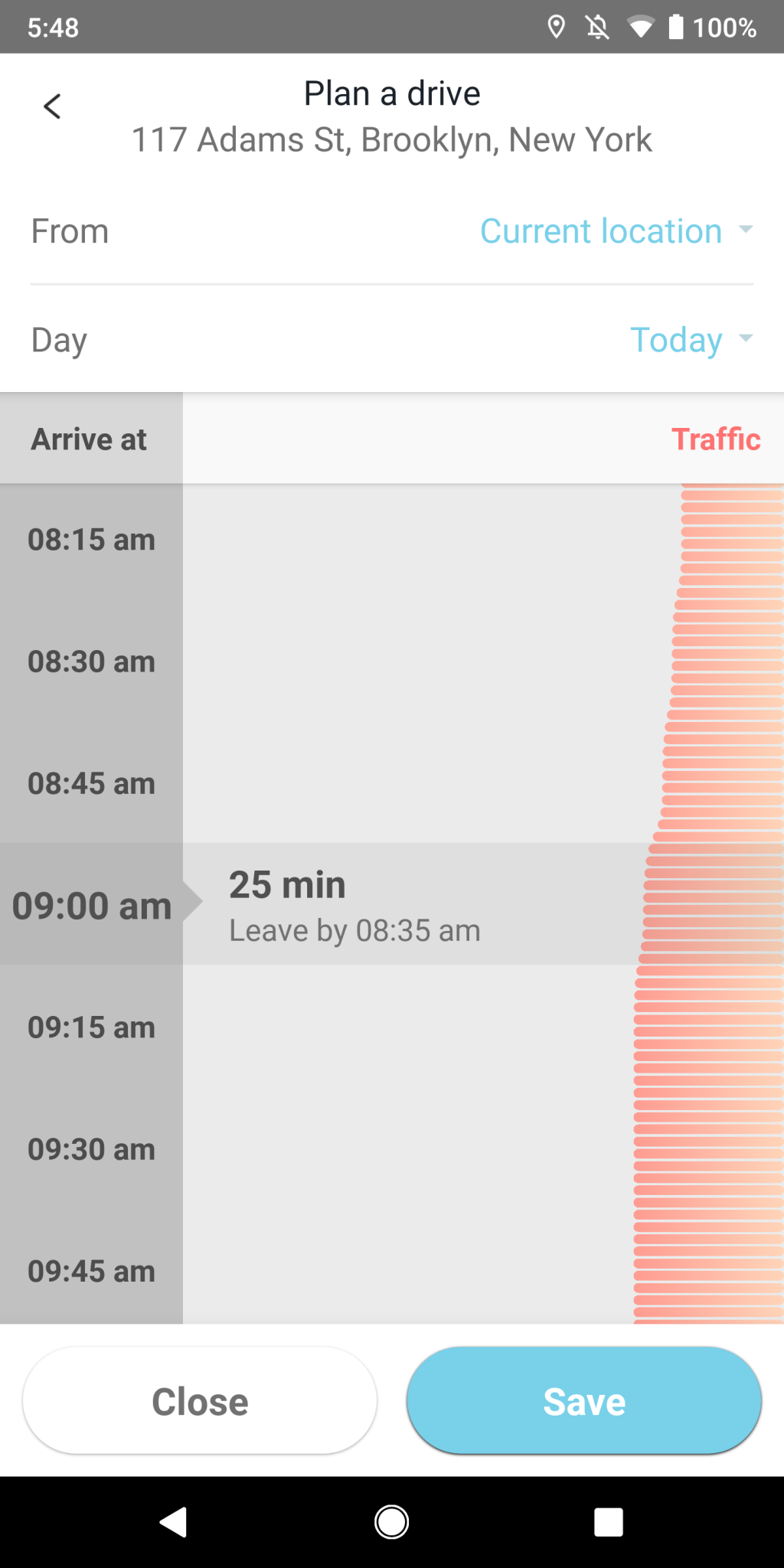
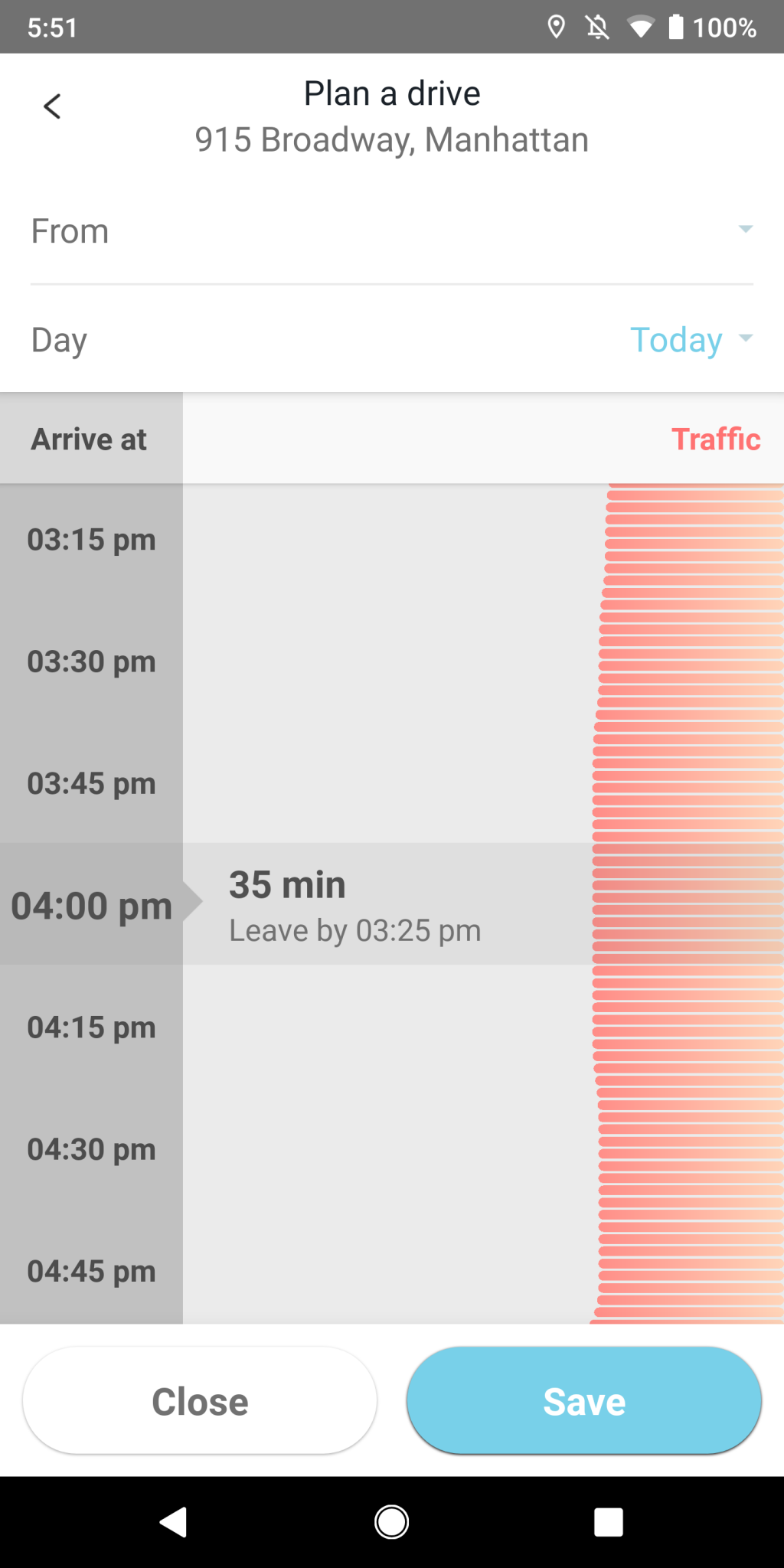
Given that Google (which owns Waze) has this data, I would love to see Google add this feature to Maps and apply it to
I would also like Google to add this data to
Imagine if this feature was available in Resy and Open
We are living in a time when our phones and the services we use know so much about us and the world around us. That is problematic and getting more so. But it is also true that can offer magical experiences that makes our lives so much better. This plan a trip feature and other places it can be applied is an example of the latter.
One of the most vexing issues facing NYC right now is our transportation mess and at the heart of it is the subway system.
My favorite chronicler of the subway mess is Aaron Gordon and his Signal Problems blog/newsletter.
If you want an example of the quality and clarity of Aaron’s analysis and writing, I would point you all to his post on Amazon HQ2 and the transportation issues it presents.
So what does all of this have to do with Funding Friday? Well, I am glad you asked.
Aaron is offering regular readers the opportunity to subscribe for $50/year and help support his efforts to shine a bright light on the MTA and all of its issues.
I think we need more journalism like the kind that Aaron is providing and so I signed up for the $50 today.
If you are a NYC resident and ride the subways regularly and want to stay on top of what’s going on, I strongly suggest subscribing to Signal Problems and while you are at it, you might consider helping to fund this effort with an annual (or monthly subscription). You can do that here.